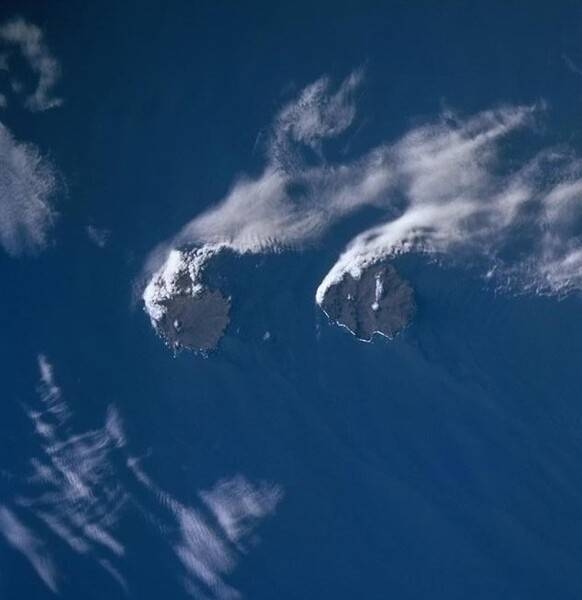10 Photos
Filter Categories
All
Filters
The Kerguelen Islands lie in the South Indian Ocean in a triangle formed by Australia, Africa, and Antarctica. At 1,850 m, the islands' highest point is Mount Ross, capped by a white glacier in this satellite image. Glaciation is also evident in the jagged fjords cut into the islands. The Kerguelen Islands, a territory of France, consist of one main island surrounded by about 300 smaller islands. Photo courtesy of NASA.
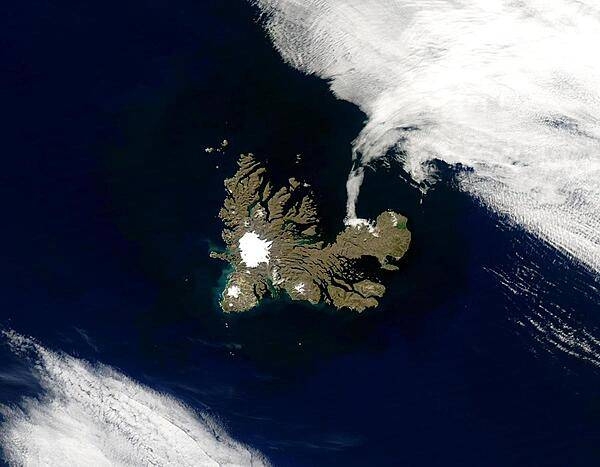
The Kerguelen Islands are an overseas territory of France. But their far-off location in the southern Indian Ocean places these islands far closer to Antarctica than to mainland Europe. In fact, the islands are so remote and the landscape so harsh that they have also been called the “Desolation Islands.” On 28 October 2016, NASA’s Terra satellite captured this natural-color image of the Kerguelen Islands. Grande Terre (French for “large land”) is the most sizeable in the island group. Its steep fjords and peninsulas are ringed by hundreds of smaller islands, which bring the archipelago’s total land area to 7,215 sq km. Penguin and seal populations are among the wildlife that thrive on Grande Terre. But because of its remoteness - and the severely cold, windy weather - you won’t find many people. Most residents of the island are scientists based in the settlement of Port-aux-Français, where they study everything from geology and biology to weather and climate. Photo courtesy of NASA.
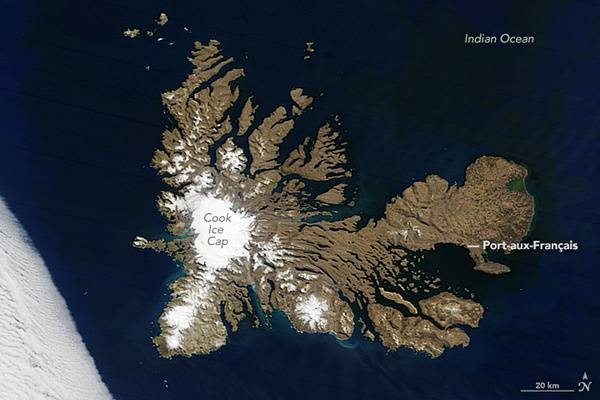
A rare break in the clouds allowed a satellite a chance to capture this photo-like image of the Kerguelen Islands. Located in the southern Indian Ocean roughly midway between Africa, Australia, and Antarctica, the Kerguelen Islands experience a fierce climate, with incessant, howling winds and rain or snow nearly every day. At a latitude of about 49 degrees south, the islands lie in the path of the "Furious Fifties," a belt of westerly winds that whip around the Southern Hemisphere, mostly unimpeded by land.
The islands were formed over millions of years by a series of lava flows. The perimeter of the large island is carved by fjords, and the rocky landscape is very sparsely vegetated with grasses, mosses, and a plant in the cabbage family. Glaciers are scattered across the island. The largest is Cook Glacier, in the west. The highest point on the island is Mount Ross, which has an elevation of 1,850 m; it is also thought to be the youngest volcanic peak on the island. In a handful of fjords, the water appears greenish. The color is probably due to very fine sediment ground down by the enormous friction the glaciers generate as they scrape over the land. Rivers and streams flush this sediment out to the coast.
Despite the challenging climate, several animals and birds make their homes at Kerguelen or use it as a stopping over point in their migrations or during breeding. Among the wildlife on the Kerguelen Islands are several species of penguins, elephant and fur seals, and dozens of species of birds, including terns and albatrosses. The sea makes this "wildlife sanctuary" possible; the islands are located along the Antarctic Convergence Zone, where the icy waters of the Southern Ocean meet the warmer waters of the Indian Ocean. The waters in this mixing area are very rich in nutrients, which support ocean plants (phytoplankton) that are the foundation of the ocean food web. Photo courtesy of NASA.
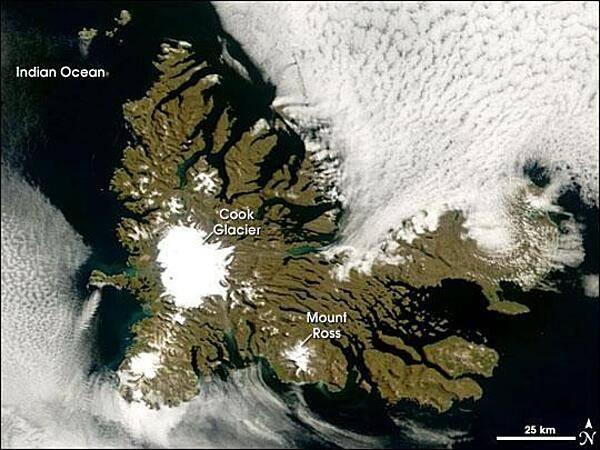
Mac Murdo and Howe Islands are two of the 300 islands of the remote Kerguelen Archipelago, located in the southern Indian Ocean. The coastlines of many of these islands are occupied by giant kelp beds. The surface wave pattern that travels southeastward along the gray-blue ocean surface and through the kelp beds is visible due to sunglint, the mirror-like reflection of sunlight off the water. The sunglint also improves the identification of the kelp beds by creating a different water texture between the dark vegetation and the reflective ocean surface. Image courtesy of NASA.
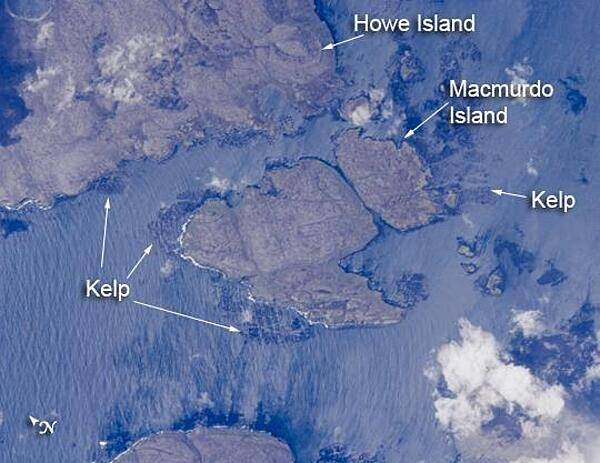
This photograph shows details of the reefs surrounding Glorioso Island (îles Glorieuses), one group in the îles Eparses, that was taken 17 June 2001 from the International Space Station. The airfield, the only sign of habitation, is easily identified. Photo courtesy of NASA.
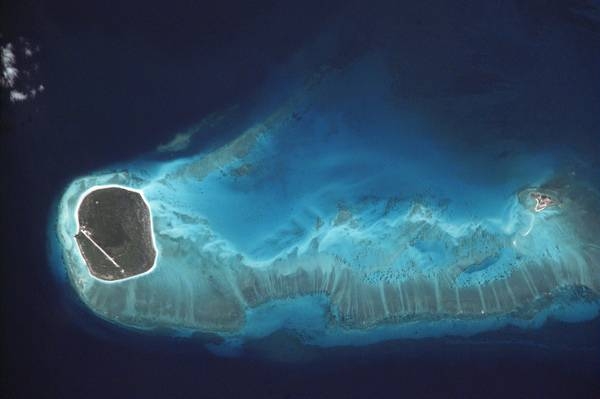
This photograph of Bassas da India, an uninhabited atoll in the îles Eparses group of the Indian Ocean, has an almost surreal quality due to varying degrees of sunglint. Sunglint is caused by light reflecting off a water surface directly back towards the observer. Variations in the roughness of the water surface - the presence or absence of waves due to wind and currents - will cause differences in the intensity of the sunglint. In this image, the presence of currents is highlighted as darker patches or streaks (image left and upper right). In contrast, shallow water in the lagoon presents a more uniform, mirror-like appearance, suggesting that there are no subsurface currents. Photo courtesy of NASA.
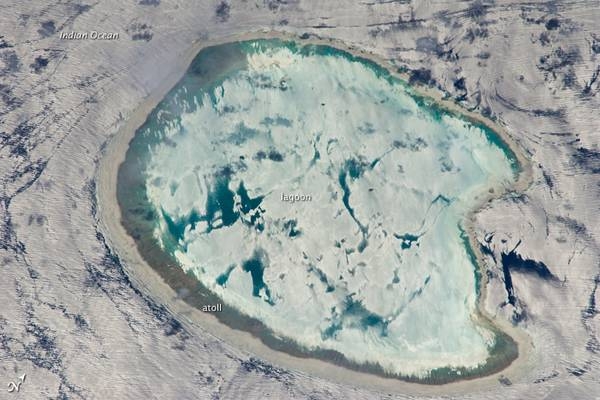
Europa Island is the focus of this image, acquired on 3 April 2022, with the Landsat 9 satellite. It is part of the overseas French territory that includes the Îles Éparses, or “scattered islands,” dispersed around Madagascar. Europa Island spans about 28 sq km, making it the largest of the Îles Éparses. It was initially an atoll that became exposed at the sea surface around 90,000 years ago. The atoll progressively filled in, and it slowly transformed into the island we know today. Vegetation across much of the island likely has not changed much since naturalists started visiting in the early 20th century. Dry forests still grow along the oldest and highest parts of the island, where the ground is rocky. Herbaceous plants and grasses spring from the newer surfaces that rise just a few centimeters above sea level, and bushes prefer the coastal areas. The native vegetation provides critical breeding habitat for seabirds, including the red-tailed tropicbird, the red-footed booby, and the great and lesser frigatebird. Another important habitat - the Grand Lagoon - cuts far into the island. Saltwater mangroves dominate the lagoon’s shoreline, while a sandy beach covers its western side. This beach, the lagoon, and the island’s shore all support each life stage of the island’s numerous sea turtles. Europa has been called the largest nesting site for green turtles in the Western Indian Ocean. The most obvious evidence of human activity in this image is the airstrip, built in 1973. Photo courtesy of NASA.

The small island of Juan de Nova, one of the îles Eparses (scattered islets) in the Indian Ocean to the west of Madagascar, was photographed by the Space Station Expedition 5 crew on 11 August 2002. At the top of the photograph it is just possible to make out the wreck of the cargo ship SS Tottenham, which ran aground in 1911 on the islands southwest coast. The northeast coast is dominated by a shallow lagoon. The island is known as a nesting site for green turtles and supports colonies of sooty and greater crested terns. Photo courtesy of NASA.
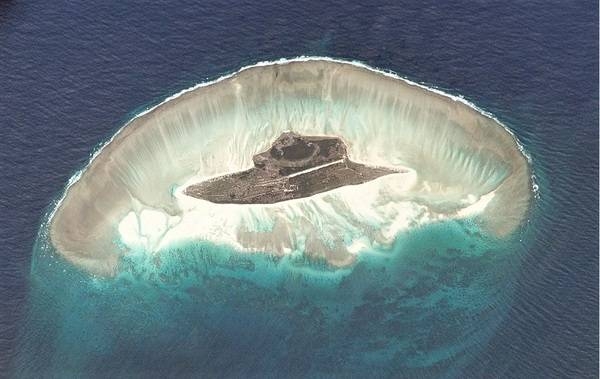
The Landsat 8 satellite acquired this close-up view of Amsterdam Island on 26 March 2015. This volcanic summit sits near the East Indian Ocean Ridge, and it is the northernmost volcano above the water line on the Antarctic plate. The highest point of the island stands 867 m (2,844 ft) above sea level. There are two calderas within an area of just 70 sq km. Some scientists suggest that the volcano was last active about 200,000 to 400,000 years ago, but there are hints that an eruption may have occurred more recently. This is the most remote active volcano on the planet. Amsterdam Island is staggeringly far from anything.
• 4,300 km (2,670 mi) from Africa
• 3,400 km (2,100 mi) from Madagascar
• 5,000 km (3,100 mi) from Sri Lanka
• 3,450 km (2,140 mi) from Australia
• 3,200 km (1,990 mi) from Antarctica. Photo courtesy of NASA.
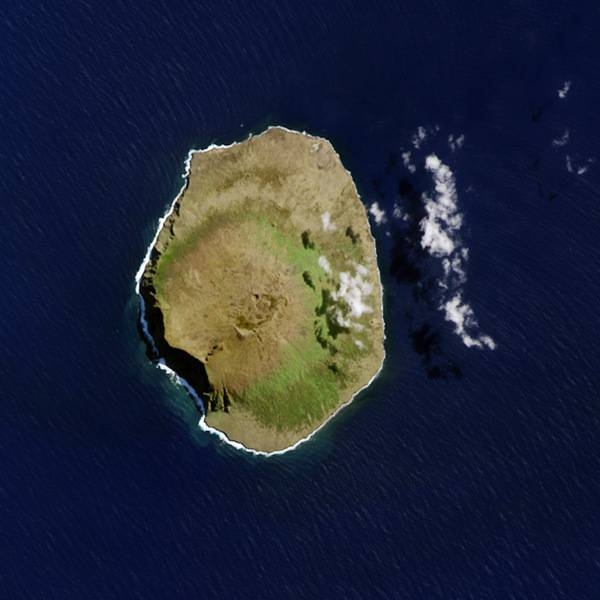
The Crozet Islands (Îles Crozet) are a sub-Antarctic archipelago of small islands in the southern Indian Ocean. They form one of the five administrative districts of the French Southern and Antarctic Lands. This photo from a Space Shuttle mission, taken on 14 December 1998, shows the easternmost islands in this group, Île de la Possession and Île de l'Est. With an area of 150 sq km, Île de la Possession is the largest island of the group and the only inhabited one. It has a rugged landscape of mountains cut by deep glaciated valleys. The coastal areas and valleys are covered with herbaceous sub-Antarctic vegetation. The island's few inhabitants staff of the Alfred Faure Research Station at the eastern end of the island, which has a capacity of about 20 people. Île de l'Est, the easternmost in the archipelago, lies about 20 km east of Île de la Possession. It is the most mountainous isle in the archipelago, with a highest point of 1,090 m. Its landscape is mainly bare rock with a rugged coastline of high cliffs; it is dissected by several steep-sided valleys of glacial origin. Photo courtesy of NASA.
